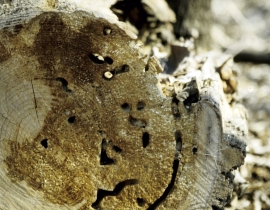By Jodi Zirbel
What does it look like?
Carpenter ants are found in most parts of the world, but in the United States the most common species is the black carpenter ant, Camponotus pennsylvanicus. Other carpenter ant species in the LACE w:st=”on”>U.S.LACE> include Red carpenter ants, Camponotus ferrugineus, and Smaller carpenter ants, Camponotus nearcticus.

Photo by Joseph O’Brien
Among the largest ant species, carpenter ants range in size from 3/8 inch for worker ants up to 1 inch for winged queen ants. Although other ant species may appear similar, carpenter ants have a smooth, convex thorax, whereas other species feature an uneven or notched thorax. In addition, when viewed from the side, carpenter ants have one node on their waist (the area between the thorax and abdomen) while other species feature one or two nodes.
Winged carpenter ants are often mistaken for termites, however termites are lighter in color and have a larger waist, wings and antennae.
Host material and range
Surprising to some, carpenter ants do not eat wood, but rather use it for nesting purposes. Preferring to nest in wood that has moisture content well over 15 percent, these nests can be found outdoors in rotting trees and stumps, or indoors in high-moisture areas — such as kitchens and bathrooms — where leaks can occur, or in places where wood can be adversely affected from rain such as steps, windows and under roofing.
Although carpenter ants prefer high-moisture nest sites, nearby satellite nests can be located in dry areas. These satellite nests consist of larvae, pupa and workers and since they are devoid of eggs, don’t require high moisture levels.
Current threat
One of the most difficult ant species to control, the most common effect of carpenter ants is the nuisance factor. However, it’s important to remember that carpenter ants can cause significant damage to both homes and trees. A large nest, the parent colony, will contain a queen and as many as 2,000 worker ants. As the colony expands, worker ants will cut further into the wood, creating galleries that enlarge the size of the nest for the ever-growing colony. Therefore, a nest that goes undetected will continue to grow, potentially causing structural problems for home and trees.
Although carpenter ants will not kill a living tree, openings into healthy trees are very attractive to these pests. Once inside, carpenter ants will continue to expand their colony by tunneling further into the tree. Although it may not kill the tree directly, this tunneling will reduce the structural integrity of the tree, making it more prone to wind breakage and other results of structural weakening.
In addition, the nests created by carpenter ants are easy feeding grounds for other more invasive pests such as wasps and hornets. Studies are also being conducted as to the likelihood of carpenter ants transporting diseases, such as chestnut blight, from tree to tree.
Prevention tips
The best way to prevent a carpenter ant invasion is to remove dead trees and stumps, and clip back tree limbs that hang over the side of the house or directly touch the structure as these create easy paths for carpenter ants nesting in a dead limb to infiltrate a structure. In addition, if the presence of carpenter ants is found on or near a living tree, treat it with a recommended pesticide.
Treatment tips
The most difficult part of controlling carpenter ants is the ability to locate and destroy their nest. Once the nest is found, it is recommended that formulations containing abamectin, boric acid, hydramethylnon or sulfuramid are used to eradicate the colony. Once the ants are eliminated, damaged wood should be treated and sealed to prevent future nesting. Of course, if the nesting occurred in a tree that is no longer salvageable, tree removal is recommended.
What can you do?
The best solution is to prevent the onslaught of carpenter ants. Eliminate potential nesting sites by removing dead tree stumps and clipping back dead tree branches that hang over homes and garages. If ants are found, proactively remove them from healthy, living trees.
Jodi Zirbel is with Epic Creative, Wis. Article provided by Mauget, a leader in micro-injection and micro-infusion tree care. Contact Mauget or visit www.Mauget.com to learn more about carpenter ants, prevention tips and proper pesticide application and use.
This Article was taken from ArborAge Magazine published by Green Media. June Issue 2010


